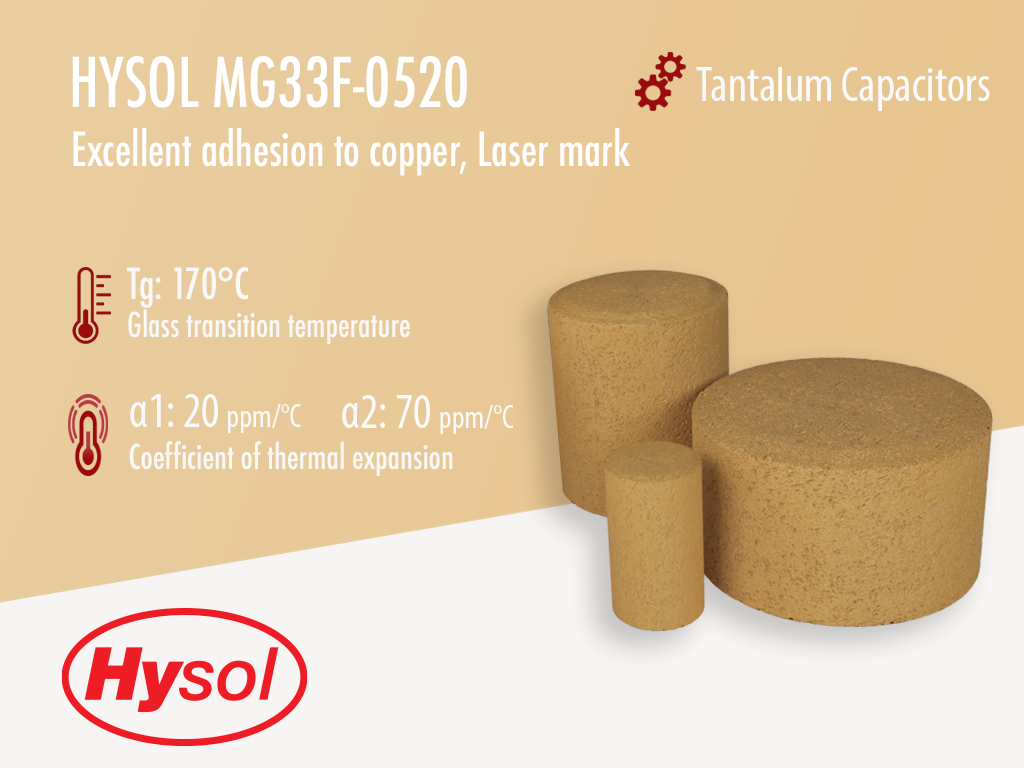Hysol MG33F-0520 | Gold Epoxy Mold Compound
- Lasemark capability
- Low moisture absorption
- Solvent resistant
Product Description
Hysol MG33F-0520 is a first generation gold epoxy molding compound that is specifically designed for use in high volume molding of tantalum capacitors. It is a silica filled, environmentally friendly 'green' molding compound with high thermal cycling stability, low stain and low moisture absorption. It has been successfully used for surface mount Mno2 tantalum capacitors and reed relays. Its solvent resistance makes it suitable for use with automotive fluids such as mineral spirits and ethylene glycol.
Hysol MG33F-0520 has excellent moldability and fast cycle times while also offering lasermark capabilities. It has low levels of ionic contaminants, excellent adhesion to copper and is stable after multiple thermal cycles. The main difference from MG33 is that it contains a flame retardant (F) which allows it to meet the UL94 V-0 flammability rating.
Curing Time
- 30 to 45 seconds @170°C
- 1.0 to 1.5 minutes @150°C
Post Cure
- 2 hours @150°C
Technical Specifications
| General Properties | |||||||
| Color Color The color | Gold | ||||||
| Specific Gravity Specific Gravity Specific gravity (SG) is the ratio of the density of a substance to the density of a reference substance; equivalently, it is the ratio of the mass of a substance to the mass of a reference substance for the same given volume. For liquids, the reference substance is almost always water (1), while for gases, it is air (1.18) at room temperature. Specific gravity is unitless. | 1.87 | ||||||
| |||||||
| Chemical Properties | |||||||
| Water Extract Conductivity | 0.000021 Ohm | ||||||
| Water Extract pH | 6.5 | ||||||
| Electrical Properties | |||||||
| Volume Resistivity Volume Resistivity Volume resistivity, also called volume resistance, bulk resistance or bulk resistivity is a thickness dependent measurement of the resistivity of a material perpendicular to the plane of the surface. | 1.3x1016 Ohms⋅cm | ||||||
| Thermal Properties | |||||||
| |||||||
| |||||||
| Glass Transition Temperature (Tg) Glass Transition Temperature (Tg) The glass transition temperature for organic adhesives is a temperature region where the polymers change from glassy and brittle to soft and rubbery. Increasing the temperature further continues the softening process as the viscosity drops too. Temperatures between the glass transition temperature and below the decomposition point of the adhesive are the best region for bonding. The glass-transition temperature Tg of a material characterizes the range of temperatures over which this glass transition occurs. | 170 °C | ||||||
| UL 94 Rating UL 94 Rating Flammability rating classification. It determines how fast a material burns or extinguishes once it is ignited. HB: slow burning on a horizontal specimen; burning rate less than 76 mm/min for thickness less than 3 mm or burning stops before 100 mm V-2: burning stops within 30 seconds on a vertical specimen; drips of flaming particles are allowed. V-1: burning stops within 30 seconds on a vertical specimen; drips of particles allowed as long as they are not inflamed. V-0: burning stops within 10 seconds on a vertical specimen; drips of particles allowed as long as they are not inflamed. 5VB: burning stops within 60 seconds on a vertical specimen; no drips allowed; plaque specimens may develop a hole. 5VA: burning stops within 60 seconds on a vertical specimen; no drips allowed; plaque specimens may not develop a hole | V0 | ||||||
| Curing Conditions | |||||||
| |||||||
| |||||||
| Transfer Pressure | 35 - 105 kg/cm2 | ||||||
Additional Information
This product claims low moisture absorption. Can it withstand X parameters for Y years?
MG33F-0520 water absorption test is 0.6% by weight (Pressure Cooker Test for 24 hours @ 121°C). This data cannot be translated into product lifetime as there are still many variables to determine the life of the device (experimental and computational modeling). What we actually need is a test during qual on HAST and/or Autoclave. Customers have different ways of extrapolating and predicting the lifetime of the device.
There are many moisture-related failure modes and several tests can be conducted to determine the likelihood of a failure mode occurring. Ultimately, Molding compounds, any of them, are semi-permeable materials that are always susceptible to moisture. It will highly depend on storage conditions, handling, equipment packaging etc.
Filler loading and resin type, can also help understand the molding compound's ability to absorb or resist moisture. A filer with more than 70% is resistant to moisture. This is one approach to make the material moisture-resistant. MG33F-0520 has 74%. On the other hand the best resin to resist moisture is Biphenyl based. MG33F-0520 is not that. The resin system is EOCN (O-Cresol Novolac Epoxy Resin)+PN.
Based on this information we assume an MSL3 level will be hard to attain. We recommend baking the molded device at 125C for 2 hours. This removes moisture and provides confidence to the package's lifetime.




